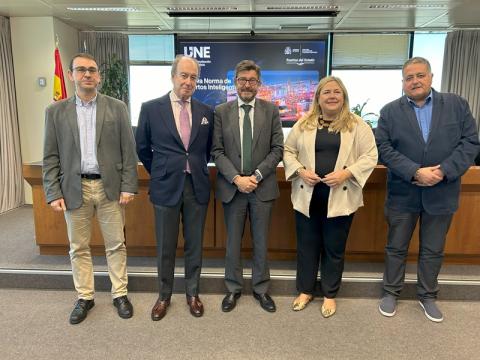
Puertos del Estado and UNE present the Standard to drive the transformation towards smart ports
- Establishes the requirements for a port to be considered a Smart Port and provides recommendations for achieving this goal
- The next step under development is a UNE standard on semantics to facilitate interoperability between systems
27-11-2024 (Puertos del Estado). Puertos del Estado and the Spanish Association for Standardization (UNE) have presented the new UNE 178110 Standard today. This standard defines the requirements a port must meet to be classified as a smart port and provides recommendations for achieving this status. UNE 178110 was published by the Spanish standardization body and promoted by Puertos del Estado.
This new UNE Standard will facilitate the transformation and evolution of ports into Smart Ports, enhancing their management and efficiency. Moreover, it will contribute to the creation of new value-added services between Port Authorities and companies within the logistics and port community, ultimately strengthening their relationship with cities.
Álvaro Rodríguez Dapena, President of Puertos del Estado, emphasized that this standard “boosts the goal outlined in the Strategic Framework to achieve intelligent and synchromodal ports, reinforcing the competitiveness of the state-owned port system.”
For his part, Alfredo Berges, President of UNE, noted, “Standardization is a strategic tool to successfully address major organizational challenges, enabling the implementation of public policies. This new UNE Standard, led by Puertos del Estado, marks a milestone for Spanish ports by defining a reference framework that will facilitate their evolution into smart ports, thus contributing to the sector’s shared progress.”
The standard specifically states that “technology alone is not enough to create a smart port. Smart ports must adopt a strategic response model typical of ecosystems with interconnected components that coordinate with one another to achieve optimal results, making them more attractive and competitive for clients, users, and their surrounding environments.”
The document outlines the range of activities and services a port must offer to qualify as a smart port. These are categorized into sustainability (encompassing economic, environmental, and social aspects), customer experience, governance (of services and data), interoperability, connectivity, and digital platforms. Each of these elements is further developed in the standard, which also defines the various phases a port must go through to achieve smart port status as described in the document.
Puertos del Estado is collaborating with the National Accreditation Entity (ENAC) to establish a certification scheme that will enable independent third-party certification of compliance with the standard.
Following the publication of this standard, Puertos del Estado is also driving the development of a new document on semantics. As Jaime Luezas, Head of the Port Community Services Area, explained, this document will “facilitate system interoperability, a fundamental step in enhancing digitalization and technological innovation in ports.”

